
Grevillea flexuosa, commonly known as zigzag grevillea or tangled grevillea, is a species of flowering plant in the family Proteaceae and is endemic to the south-west of Western Australia. It is an erect shrub with divided leaves, these lobes with three to five triangular lobes, and cylindrical clusters of cream-coloured to pale yellow flowers.

Grevillea eriostachya, also known as flame grevillea, orange grevillea, or honey grevillea, is a species of flowering plant in the family Proteaceae and is endemic to western parts of Australia. It is a shrub with a leafy base, mostly linear leaves and conical groups of bright yellow flowers on long canes above the foliage.
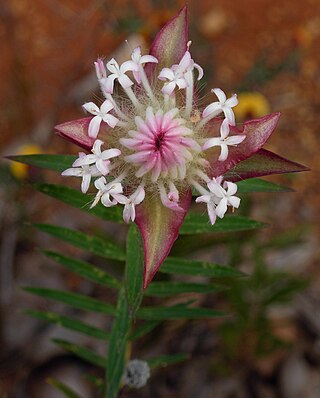
Pimelea spectabilis, or bunjong, is a species of flowering plant in the family Thymelaeaceae and is endemic to the south-west of Western Australia. It is an erect shrub with very narrowly elliptic leaves and heads of white, pale pink or pale yellow flowers surrounded by 4 or 6 egg-shaped involucral bracts.

Verticordia densiflora, commonly known as compacted featherflower, is a flowering plant in the myrtle family, Myrtaceae and is endemic to the south-west of Western Australia. It is a shrub with small leaves, usually small pink and white flowers and which is widespread in the south-west of the state. It is a variable species and in his 1991 paper, Alex George formally described five varieties.

Grevillea tenuiflora, commonly known as tassel grevillea, is species of flowering plant in the family Proteaceae and is endemic to the southwest of Western Australia. It is a spreading to weakly erect shrub with divided leaves, the end lobes more or less triangular and sharply pointed, and clusters of whitish and violet-tinged flowers.

Darwinia thymoides is a species of flowering plant in the myrtle family Myrtaceae and is endemic to the south-west of Western Australia. It is a low, spreading to prostrate shrub with linear to lance-shaped leaves and groups of 4 to 8 green, red or white flowers surrounded by leaf-like bracts.
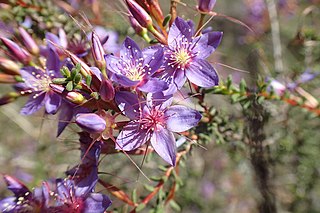
Calytrix violacea is a species of flowering plant in the myrtle family, Myrtaceae and is endemic to the southwest of Western Australia. It is a shrub with linear to narrowly egg-shaped leaves with the narrower end towards the base, and purple, star-shaped flowers.

Conostephium minus, common name pink-tipped pearl flower, is a species of flowering plant in the family Ericaceae and is endemic to the southwest of Western Australia. It is an erect shrub with linear leaves and white and purplish-pink flowers.
Pultenaea brachytropis is a species of flowering plant in the family Fabaceae and is endemic to the south-west of Western Australia. It is an erect, spindly shrub with more or less cylindrical, grooved leaves and yellow, red and orange flowers.

Pultenaea empetrifolia is a species of flowering plant in the family Fabaceae and is endemic to the south-west of Western Australia. It is a spindly, prostrate or spreading shrub with down-curved, cylindrical, grooved leaves and yellow to orange and red flowers.
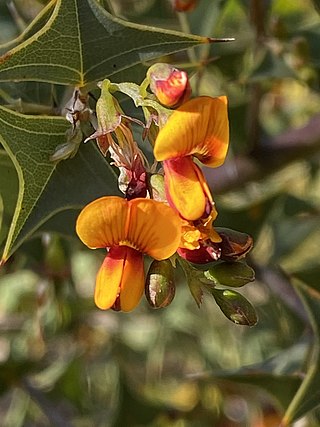
Gastrolobium trilobum, commonly known as bullock poison, is a flowering plant in the family Fabaceae, and is endemic to Western Australia. It is a small, rigid shrub with orange, yellow and red flowers.
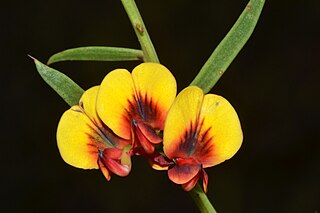
Daviesia angulata is a species of flowering plant in the family Fabaceae and is endemic to the south-west of Western Australia. It is an erect, spreading shrub with prickly, flattened phyllodes, and yellow flowers with red markings.

Daviesia longifolia is a species of flowering plant in the family Fabaceae and is endemic to the south-west of Western Australia. It is an erect, many-stemmed shrub with scattered, erect, cylindrical phyllodes and yellow and red flowers.

Lechenaultia juncea, commonly known as scarlet leschenaultia, is a species of flowering plant in the family Goodeniaceae and is endemic to the south-west of Western Australia. It is an open, ascending shrub with narrow, crowded, rather fleshy leaves, and scarlet to orange-red flowers.

Daviesia pedunculata is a species of flowering plant in the family Fabaceae and is endemic to south-western Western Australia. It is a spreading or sprawling to erect shrub with erect, egg-shaped to elliptic phyllodes, and yellow and maroon flowers.
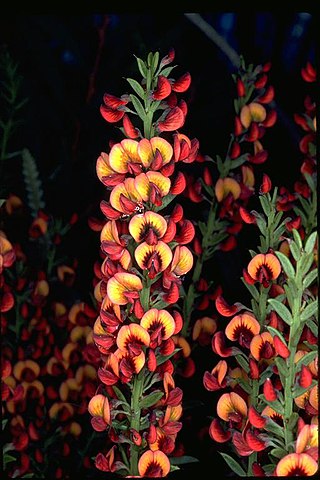
Daviesia polyphylla is a species of flowering plant in the family Fabaceae and is endemic to the south-west of Western Australia. It is a bushy, spreading, glabrous shrub with narrowly egg-shaped or elliptic, sharply-pointed phyllodes and yellow and dark red flowers.

Daviesia quadrilatera, commonly known as buggery bush, is a species of flowering plant in the family Fabaceae and is endemic to the south-west of Western Australia. It is a robust, erect, glabrous shrub with angular branchlets, vertically flattened, sharply-pointed quadrilateral or triangular phyllodes with a sharp point on the end, and yellow to orange and red flowers.
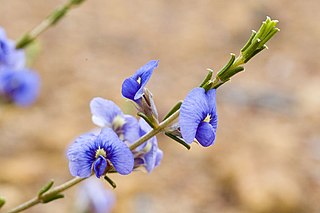
Mirbelia floribunda, commonly known as purple mirbelia, is a species of flowering plant in the family Fabaceae and is endemic to the south-west of Western Australia. It is an erect, slender or straggling, much-branched shrub with narrowly linear leaves and bluish-purple flowers.

Mirbelia ramulosa is a species of flowering plant in the family Fabaceae and is endemic to the south-west of Western Australia. It is an erect, much-branched, spiny, leafless shrub with yellow and red, purple or brown flowers.
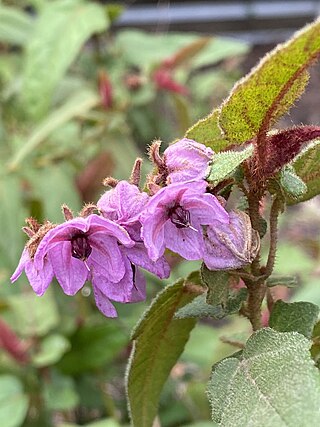
Thomasia paniculata is a species of flowering plant in the family Malvaceae and is endemic to the south-west of Western Australia. It is a spreading shrub with heart-shaped to narrowly egg-shaped leaves and pinkish-mauve flowers.



















